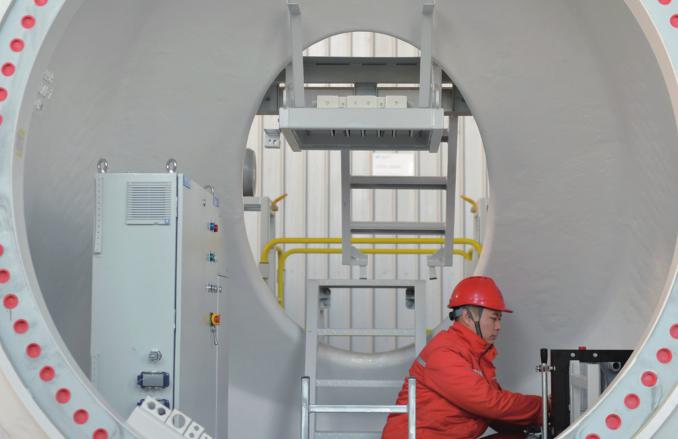An Early Move
2019-02-13ByLiXiaoyang
By Li Xiaoyang
To make financing more accessible for micro, small and private enterprises and to manage liquidity during a period of New Year celebrations as well as tax deductions, Chinas central bank slashed the reserve requirement ratio (RRR) for fi nancial institutions and will implement an encore later this month.
The Peoples Bank of China (PBC) announced on January 4 that the share of deposits fi nancial institutions are required to hold in reserve will be cut by 1 percentage point.
The PBC cut the RRR by 0.5 percentage point on January 15 and will repeat the act on January 25, which will collectively inject 800 billion yuan ($116.6 billion) into the market to increase loan funding sources for domestic enterprises. It will also reduce the cost of bank interest payments by around 20 billion yuan ($2.9 billion) annually, which will help lower financing costs for the real economy.
The measure will ease liquidity constraints since the forthcoming period will mark the maturity of commercial banksmedium-term lending facility, funds that can support fi nancial institutions in seeking additional capital, and see tightened liquidity as people exchange cash gifts during the Chinese Lunar New Year, Zong Liang, chief researcher with Bank of China (BOC), told Beijing Review.
“This can help offset liquidity fluctuations before the Spring Festival and allow financial institutions to improve the support for small, micro and private businesses to better serve the real economy,” Zong said.
The PBC said the move is a moderate change amid monetary easing following the Central Economic Work Conference, the annual meeting to chart the course for the economy in 2019, which highlighted the goal to maintain sound liquidity. The bank said it will continue to implement a prudent monetary policy and refrain from using “a deluge of stimulus.”
Easing fund access
Facing downward pressure and mounting uncertainties in the external market, the Chinese economy has been experiencing a growth slowdown, partly caused by contraction in the manufacturing sector. According to data from the National Bureau of Statistics, the purchasing managers index dropped to a record low of 49.4 in late December 2018, the first time in recent years it dropped below the 50-point threshold dividing contraction and expansion.
“It suggests that domestic entrepreneurs lack confi dence in the market due to the burden caused by taxes and fees and diffi culties in fi nancing,” Gong Yuhang, Dean of the China Enterprise Finance Research Institute, told the media.
To boost market confidence, the priorities Chinese policymakers unveiled at the economic conference included improving countercyclical adjustments, cutting taxes and fees and supporting private enterprises. Since small, micro and private enterprises play a key role in propelling economic growth and employment, such companies will be offered more access to funds so that their debt default risks can be reduced.
The central bank said financial institutions will support privately owned small and micro companies through a range of fi nancial tools including bonds, bank lending and equity. Before the RRR announcement, it already eased evaluation rules on January 2 to encourage inclusive fi nancing for small and micro enterprises, rural residents and low and middle-income urban groups.
Financial institutions can deposit less in the central bank as reserve money if they lend a certain share of their loans to small and micro firms each borrowing less than 10 million yuan ($1.46 million). The threshold was previously set at 5 million yuan($730,000).
According to Lian Ping, chief economist of the Bank of Communications (BOCOM), one of Chinas largest commercial banks, more efforts are needed to make inclusive fi nancing more effective. “The most prominent problem of inclusive fi nancing in China is that the financial structure is not fullfledged. The direct financing system and banks targeting small and micro enterprises need to be improved,” Lian told Beijing Review.
The central bank will continue to tighten its regulation on financial holding companies this year to defuse risks caused by shadow banking and Internet f inancing. In 2018, mea-sures to regulate shadow banking—lending and other financial activities by unregulated institutions or under unregulated conditions—saw initial achievements in deleveraging and risk control but there was a downside as well. Small and private businesses funding resources became constrained since the shadow banking sector provides easier financing. The authorities have now recognized the role of shadow banking and are trying to develop it under regulations.
The sector has facilitated the fi nancing of private enterprises in recent years, making it deserve more room to develop as long as appropriate regulation is in place, Xu Xueming, Vice President of the Postal Savings Bank of China, said at a forum on December 23, 2018.
Positive signals
In 2018, the PBC cut RRR four times, injecting a total of 2.3 trillion yuan ($337.8 billion) into the market. The cuts this year, a followup move, still focus on boosting the real economy while avoiding over-escalation of monetary easing.
“The RRR cuts were mostly launched later in the previous years,” BOCs Zong said. But the early move this year signals determination to resolve prominent economic problems and boost the confidence of private enterprises, laying a solid foundation for steady economic performances in 2019, he added.
Besides supporting the private sector, the move can also help ease the real estate market. The fundamental policy of controlling speculation will remain consistent, said Yan Yuejin, Research Director of the E-house China R&D; Institute, a property research agency.
BOCOMs Lian said the RRR cuts this year may see a smaller margin and lower frequency than in 2018, and the possibility of cutting RMB benchmark interest rates for deposits and loans is slim. As trade talks between China and the United States progress and the momentum of the dollars strengthening weakens, the depreciation pressure on the renminbi will ease.
A report by the Guanghua School of Management of Peking University on January 3 said the central bank is expected to reduce RRR by around 2 percentage points altogether in 2019 and adopt various monetary policy tools to adjust liquidity, with a focus on improving the monetary transmission mechanism to smooth funding channels.
Lian said greater focus is needed to ensure capital fl ow into the real economy since large-scale monetary easing may not exert considerable effect due to adequate liquidity. In addition to the targeted RRR cuts, measures such as improving the supply of lowcost loans can be adopted to cut financing costs for domestic enterprises.
“To inject more capital into the real economy, the fi nancial structure needs to be improved, mainly in terms of direct financing, especially boosting the stock market, while stability of the domestic market needs to be maintained,” he added.
